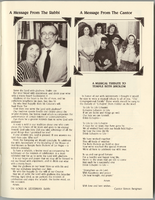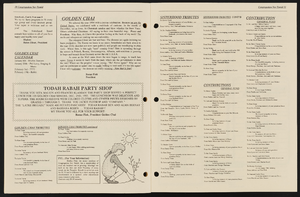Search the Special Collections and Archives Portal
Search Results
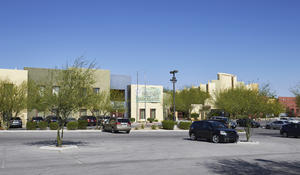
Photograph of Congregation Ner Tamid exterior, Henderson, Nevada, May 24, 2016
Date
Archival Collection
Description
Exterior of Congregation Ner Tamid on the Greenspun Campus for Jewish Life, Learning & Spiritual Renewal.
Image
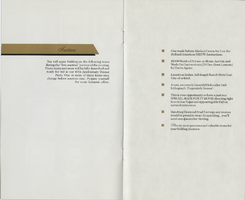
Temple Beth Sholom 40th Anniversary Celebration invitation, April 23, 1988
Date
Archival Collection
Description
An invitation to Temple Beth Sholom's 40th anniversary celebration at the Alexis Park Resort in Las Vegas, Nevada.
Text

Dorothy Eisenberg interview, March 8, 2017: transcript
Date
Archival Collection
Description
Multicultural advancements in Las Vegas cannot be mentioned without speaking on the monumental contributions of Dorothy Eisenberg. From 1971 to 1998, she was involved with over 25 local organizations and committees and had the honor of having an elementary school named after her. Eisenberg’s beginnings start in the midst of the all American melting pot experience though immigration. Her mother came to the United States from Russia at age twelve and her father from Austria at age sixteen to go upholstery school. Upon marriage, they settled down in Philadelphia after the World War II. They raised Dorothy and her siblings to contribute to the community despite the anti-Semitism that was displayed there on a regular basis. Signs that said, “No dogs and Jews allowed” were common place. After her first husband died, leaving her as a single mother of four little girls, she didn’t allow herself to be trampled by her circumstances by enrolling in Temple University to be a teacher at a time when the university had stigma towards older students. Upon her marriage to her second husband, the family moved to Las Vegas where she found a spiritual home for her family at Temple Beth Sholom, where her children went learned to deeply appreciate their Jewish heritage and attended Hebrew school. Having always been involved with politics in Philadelphia, she faced personal discrimination due to her religion when she was searching for organizations to involve her time. She eventually found a home with the League of Women Voters in 1965 and became involved with the Observers Corp and became aware of what was going on with the African American community from community based research and dialogue. She played a key role as president of the organization and faced heat for her involvement in the desegregation of sixth grade centers with the Kelly vs. Guinn decision in 1972 and was involved with the Welfare Rights Movement. She met Ruby Duncan and Jane Fonda, and she even showed up to the march with her daughters. Eisenberg was heavily involved with her namesake school through meetings with principals at least once a year, reading to students in the classroom, and bringing latkes to the school on Hanukkah. She continues the intergenerational legacy of educational involvement set forth by her parents with supporting her children, grandchildren and great grandchildren in the school as well. Dorothy Eisenberg is a true role model for Nevada and a pioneer for equal education in Las Vegas.
Text
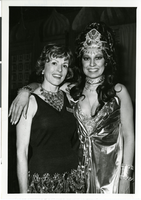
Photographs of Temple Beth Sholom belly dancers, Las Vegas (Nev.), 1974-1982
Date
Archival Collection
Description
Various photographs of Temple Beth Sholom belly dancers at the International Belly Dancers Convention at the Aladdin Hotel in Las Vegas, Nevada.
Image

Photographs of Abe Saltzman, Sara Saltzman, and family, 1970s - 1980s
Date
Archival Collection
Description
Group and portrait photographs of Abe Saltzman, Sara Saltzman, and their family.
Image
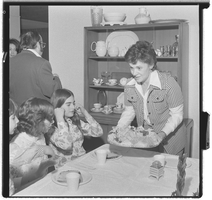
Photographs of party hosted by Rabbi Schnairson, February 08, 1975
Date
Archival Collection
Description
Various photographs of unidentified people attending a party hosted by Rabbi Schnairson. 120mm negatives.
Image

Album for the Americanism and Civic Affairs Committee of the Las Vegas B'nai B'rith Women, 1955
Date
Archival Collection
Description
An album documenting some of the key events and activities that the Americanism and Civic Affairs Committee of the Las Vegas B'nai B'rith Women, Chapter No. 415, participated in during 1955. Created by Mrs. Russell Sherman, the Americanism and Civics Chairman from 1955-1956, the album contains various items including text passages, newspaper clippings, letters, programs, photographs, announcements, and certificates.
Image

Transcript of interview with Margo Mink Colbert by Barbara Tabach, November 11, 2014
Date
Archival Collection
Description
Interview with Margo Mink Colbert by Barbara Tabach on November 11, 2014. Colbert discusses her upbringing in New York and her schooling at the High School of Performing Arts and Julliard. She is a choreographer and faculty member at the University of Nevada Las Vegas.
Margot Mink Colbert was born in 1935 in New York City, to parents of different economic backgrounds who shared a Jewish immigrant heritage. She attended Julliard and studied under modern dance pioneers like Martha Graham and Jose Limon. Margot honed her skill for choreography, and took her first job in academia as a Senior Lecturer in the dance department at the University of Wisconsin-Madison. In 1991, she moved to the University of Nevada, Las Vegas to take a one-year appointment as an instructor. A year later, she was hired into a tenure track position. Margot is now a Professor at the University of Nevada-Las Vegas, assistant chairperson of and Director of Ballet in its Department of Dance. In addition, she continues to direct Ballet Mink, a dance company she founded in 1970.
Text

